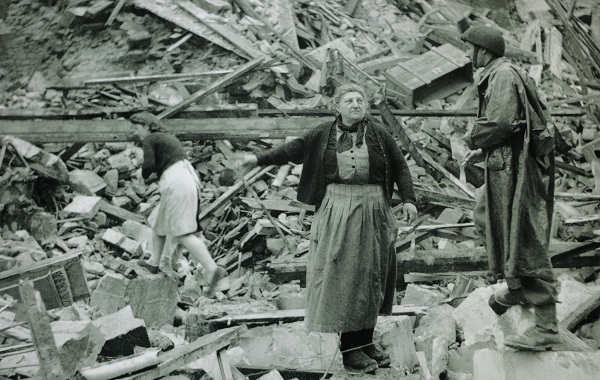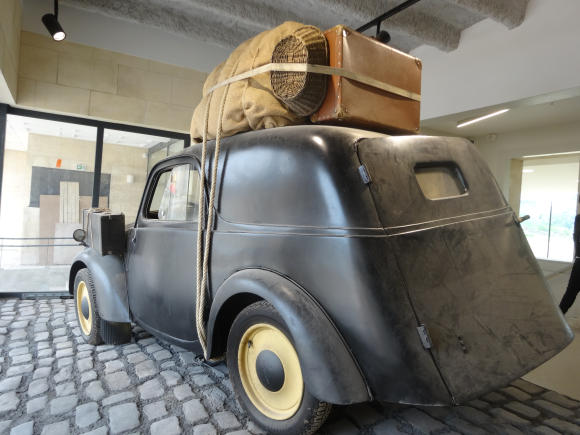
Of the 20,000 Normans who died as a direct result of WWII, the majority were killed by Allied bombardments intended to weaken the Atlantic Wall, destroy enemy forces and prevent the possibility of German reinforcement during the Invasion of Normandy. The effect of war on civilian populations is now the subject of a museum in Falaise, birthplace of William the Conqueror and site, with its surroundings, of the final combat of the Battle of Normandy 1944.
* * *
In Normandy, where dozens of museums tell about the D-Day Landing, the 75 days of the Battle of Normandy, the victory for the Allied forces against the German occupant and the Liberation, visitors to the region have, until recently, been offered scant information about the effects of war on civilian populations.
Yet, in addition to the deprivations, deportations and executions caused by the German occupant and in some cases by their French collaborators, Allied air strikes from 1942 to 1944 claimed 50-70,000 civilian victims in France. Of the 20,000 Normans who died as a direct result of the war, the majority were killed by Allied bombardments intended to weaken the Atlantic Wall, destroy enemy forces and prevent the possibility of German reinforcement during the Invasion of Normandy. Furthermore, about 150,000 Normans lost or had to leave their homes during the spring and summer of 1944.

Those numbers, significant as they are, seem small when one thinks—or tries to grasps—that the Second World War caused the death of over 55 million people, of which about 35 million were civilians, including through planned genocide. The First World War brought the military front to the doorsteps of civil life, leading to the death of large numbers of civilians as a direct result of combat. The Second World War then confirmed that civilians were from then on fully a part of war and ideological combat. In the 21st century we are well aware (or should be) that civilians are not only collateral damage but also the targets of military and ideological attacks.
The Civilians in Wartime Memorial (Mémorial des Civils de la Guerre), a museum opened in 2016 in the small town of Falaise, examines of the effect of war on civilian populations. The museum naturally takes wartime Normandy as its prime example while also speaking of civilian victims of other conflicts around the world.
Falaise is a fitting location for this museum since it was in this area that the Battle of Normandy, which began with D-Day, June 6, 1944, ended with the defeat of the German tank division on August 22 in what is known as the Falaise (or Falais-Chambois) Pocket. The town itself, its center heavily damaged, was liberated by Canadian troops on August 17, 1944. It was in Falaise, I’ve been told, that a woman lost her 2-year-old son to bombardments on the day that she gave birth to a daughter.
As Americans, with our own civilians largely out of harm’s way during WWII, we generally focus on the war’s military aspects and on the lives and actions of soldiers and the military hierarchy. As the war recedes in time we further focus the war’s military aspects on the Normandy D-Day Landing and the ensuing several days, sometimes forgetting that a full 11 months of war in Europe was to follow, that harsh battle continued in the Pacific and perhaps even our military presence overseas for much of the past 70 years. Americans now often speak of the Beaches of Normandy as the shining example of our role in securing freedom around the world and hold it up as the best image we have of ourselves in our expeditions overseas.
It takes nothing away from America’s role in the Liberation of Europe to recognize that the effect that WWII and other wars had—and continue to have—on civilian populations, including through our own military actions. As travelers to Normandy remember, commemorate and visit the sites and scenes of D-Day and the early phases of the Invasion of Normandy, those with time to do so (for Falaise is off the beaten path for most itineraries) might also pay a visit to Falaise’s museum for an understanding of how civilian population lived and died during the war.

The Falaise museum is managed by the Memorial de Caen, the region’s major war museum—or museum of peace, as they would have it. In presenting the new museum, Stéphane Grimaldi, director of the Memorial de Caen, has written “The singularity of the Second World War is that it annihilated more civilians than soldiers. It’s estimated that 35 million civilians died – including 15 million Chinese, 8 million Russians, more than 5 million Poles, 3 million Germans. To these terrifying numbers one must add about 100 million wounded and maimed, ‘collateral’ victims of bombardments, exodus, combat and deprivations.”
While devoting major to civilian life and death in Normandy during the war, the vocation of Falaise’s museum is not to tell only a local story but to remind visitors of the difficulties and concerns of civilians during wartime everywhere.
With explanatory panels in French and in English, the visit is designed to begin at the third floor with displays about military occupation by foreign forces. The second floor then speaks of the Liberation. The museum occupies a former court building from the reconstruction period that followed the war. A remnant of the house (of a doctor and former mayor) destroyed during the war on the site is partially uncovered in the basement. While peering into that remnant one hears the sound of bombs dropping. Those bombs room comes at the end of the visit so as to leave the visitor with a reminder of the risk to all civilians in times of military conflict, though it can in fact be visited first, a foreshadow of things to come.

The Route from Caen to Falaise
The route south from Caen to Falaise, 23 miles (37 km), passes two cemeteries related to the Battle of Falaise and the Falaise Pocket. The first, coming from Caen, is the Canadian Military Cemetery at Bretteville-sur-Laize. Falaise, as noted earlier, was liberated from the German occupation by Canadian troops on Aug. 17, 1944. Beyond the Canadian Cemetery is the Polish Military Cemetery at Urville. Most of its 615 tombs there belong to soldiers and officers of the First Polish Tank Division under General Maczek, which was attached to the First Canadian Army. The Mémorial de Montormel, a museum and monument dedicated to the final days of the Battle of Normandy, is a 40-minute drive east of Falaise.

William the Conqueror and Falaise Castle
Falaise itself, much destroyed during the Battle of Normandy, is a handsome example of post-war reconstruction that even on an empty morning has a peaceable air of well-being to it. The tourist office is across the street from the museum. Between the two is Town Hall, an 18th-century survivor of the war. All three of these structures face Place Guillaume le Conquérant, William the Conqueror Square. William was born in Falaise in 1028. He would become Duke of Normandy then also King of England following his conquest of the cross-channel kingdom in 1066. He died in 1087 and is buried in the Abbaye-aux-Hommes in Caen.
William’s Castle, modified by his descendants and then the kings of France, stands several hundred yards away. The Civilians in Wartime Memorial. The royal castle is visible from the museum’s top floor.
The castle ramparts have recently been reconstructed. A previous reconstruction/creation at the entrance to the castle looks so ridiculously out of place that it nearly dissuaded this visitor from wanting to enter. But once inside the remnants of the castle inform visitors about the itinerant court of the 11th, 12th and 13th centuries through three parts: that of William’s son, with a residential dungeon (the beginning of the development of dungeon palaces), that of his grandson, then that of the king of France after 1204, when Normandy fell within the crown of France. Tablets enable visitors to see rooms as they might have appeared during those eras.
A brief walk about the center of town may include a visit to Saint Gervais Church.
The restaurant O Saveurs, 38 rue Georges Clemenceau, is a nice option for a well-prepared meal.
For opening times and other information see the following websites:
Mémorial des Civils de la Guerre (Civilians in Wartime Memorial), 12 Place Guillaume le Conquérant, 14700 Falaise.
Falaise Tourist Office, 5 Place Guillaume le Conquérant, 14700 Falaise.
Falaise Castle, Château Guillaume le Conquérant.
Mémorial de Montormel (Montormel Memorial), Les Hayettes, 61160 Montormel.
Calvados Tourist Board. Calvados is the name of the department (sub-region) in Normandy which includes Falaise, Caen, four of the five Landing Beaches, Caen, Deauville, Honfleur, etc. The fifth Landing Beach, Utah, is located in Manche.
Normandy Tourist Board. Information about the broader region.
© 2017, Gary Lee Kraut
See other articles about Normandy on France Revisited.

